|
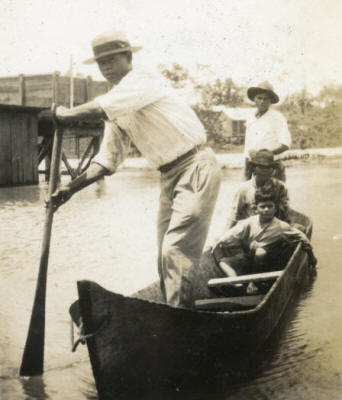 THIS IS THE seventh PAGE
of documents for the first HALF of 1928
on Nicaragua's Caribbean Coast region, housing
materials dated during the 13 days from May 19 to 31.
THIS IS THE seventh PAGE
of documents for the first HALF of 1928
on Nicaragua's Caribbean Coast region, housing
materials dated during the 13 days from May 19 to 31.
In a dizzying array of
radiograms, reports & letters,
the page focuses mainly on Captain
Edson's continuing Wanks River
Patrol (including an exceptionally
long & rich letter to his son Austin
on 22 May) and the effort by the Marines
& Guardia to gather reliable
intelligence on their maddeningly
elusive foes. Analyzing an
entirely different terrain of
struggle, the May 20 article in the Managua
daily La Noticia by
intellectual and labor activist
Sofonías Salvatierra, 'Difícil
situación de los Obreros en la Costa
Atlántica" focuses on the
recent influx of black West Indian
laborers, the inhuman conditions for
Nicaraguan workers, the companies'
inordinate social power, and the
inalienable rights of Nicaraguan
citizens before the companies and
the state. Salvatierra's piece
can be fruitfully read alongside
Alfred W. Hooker's editorial in the
Bluefields Weekly the day
before ("A Condition that Ought to
be Looked Into") on unemployment in
Puerto Cabezas. Major Utley's May 31 radiogram
shows Bragmans Bluff
Lumber Company describing its labor
policies of not encouraging
migration of West Indian blacks but
"glad to employ such labor" and
making "every effort" to "obtain
Nicaraguan labor but demand [for
work] exceeds supply."
There are also some interesting
intelligence analyses on the EDSN's
movement out of Las Segovias east
into the mining districts & beyond,
like Lt. Hall's of 19 May: "It
appears that the outlaws were forced
out of western Nicaragua and came
east to 'Try their luck'. They
then retreated west before patrols
sent from the east coast, and are
now in the country which has not yet
been reached by patrols from either
side." Well, sort of.
Only the final clause is entirely
accurate, but Hall makes a crucial
point: Sandino's strategic
decision to occupy interior zones
that are simply inaccessible to the
Marines & Guardia. With the
Eastern Area still reeling from the
EDSN attack on the Pis Pis & Siuna
mining districts, we see many
instances of collective struggle &
action among Costeños that
are entirely autonomous from the
year-old Sandinista movement.
|
|
PERIOD MAPS
|
|
1894 mosquito
shore

27 MB,
library of congress
|
1920s
Standard Fruit

6.5 mb,
US National archives
|
1928 Rio wanks
Patrol

3 mb, us
national archives
|
1931 Moravian

2.4 mb,
coMENius press
|
|
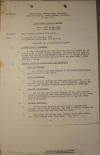
|
1.
19 May 1928.
Intelligence Period Report,
1st Lt. W. C.
Hall, Puerto Cabezas, p. 1.
"Reference: Daily
reports covering this period. ¶
Maps: (a) Ham map of Nicaragua, 1921.
¶ (b) Moravian Mission Map, file
#2-7-12. ¶ (Paragraph (2) of
Intelligence Report) ¶ 1.
NEAREST HOSTILE
ELEMENTS: ¶ a. No
late information has been received, but
the outlaws are believed to be in north
central JINOTEGA. No contacts have
been reported from patrols in the
Eastern Area and it is assured that the
outlaws are retiring before our patrols
to the area CASCA – HIJAS MOUNTAIN –
CASULI. ¶ 2.
HOSTILE STRENGTH,
DISPOSITION, AND MOVEMENTS:
¶ a. UNITS
IN CONTACT. ¶ 1. No
contacts have been reported in the
Eastern area during period covered by
the report. ¶ b.
HOSTILE STRENGTH.
¶ 1. The hostile strength has been
variously reported. It is believed
that in the area CASCA – HIJAS MOUNTAIN
– CASULI, the total bandit strength is
almost three hundred and fifty men.
¶ c.
HOSTILE DISPOSITIONS. ¶
1. The outlaws have probably returned to
the area outlined, believing themselves
safe from interference there, as our
operations in that area are more
difficult for us than any other part of
Nicaragua. ¶ 4.
HOSTILE MOVEMENTS:
¶ 1. The two bands reported in
north central JINOTEGA have probably
moved closer together. The band of
seventy mounted men headed for LAKUS has
not been reported again. ¶
2. Capt. ROSE reports May 14th: ‘Latest
report that Sandino took trail running
north from HIJAS, 6 May, 1928.’ . . . "
|
|
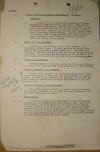
|
2.
19 May 1928.
Intelligence Period Report,
1st Lt. W. C.
Hall, Puerto Cabezas, p. 2.
" . . . e.
DEDUCTION.
¶ 1. It appears that the outlaws
were forced out of western Nicaragua and
came east to ‘Try their luck’.
They then retreated west before patrols
sent from the east coast, and are now in
the country which has not yet been
reached by patrols from either side.
Pressure from the south will probably
cause them to move north towards
HONDURAS. Pressure from the north,
for example by way of BOCAY and CASA
VIEJA, will probably cause a movement of
the outlaws to the south into more
accessible country for our patrols.
¶ 3. ENEMY
SUPPLY AND EQUIPMENT: ¶
a. A report has been received, from a
source believed to be thoroughly
reliable, that: ‘150 well armed and 200
poorly armed bandits left BOCAY heading
towards SANTA CRUZ.’ The same
source reports as unreliable information
that the bandits had many supplies and
cattle. In the area where the bandits
now are believed to be their supply will
be difficult for both food and military
equipment. ¶ 4.
WEATHER AND
VISIBILITY: ¶ a. The
rainy season is beginning, making
conditions more difficult for patrols,
and visibility and flying conditions
poor for airplanes. ¶ 5.
ENEMY’S KNOWLEDGE
OF OUR SITUATION: ¶
a. The outlaws continue to avoid our
patrols and it is expected that they
will continue to do so until they can be
placed in a position where they cannot
so escape. ¶ 6.
PROBABLE
INTENTIONS OF HOSTILE GROUPS:
¶ The outlaws continue to avoid
our patrols and it is expected that they
will continue to do so until they can be
placed in a position where they cannot
so escape. ¶
7. MISCELLANEOUS: ¶ a. A report
was received that SANDINISTAS recruits
were entering Nicaragua via RIO GRANDE
BAR and CAPE GRACIAS A DIOS. There
is a small garrison now at RIO GRANDE
BAR and another up the river at EL
GALLO. There is at present no post
at CAPE GRACIAS, but until recently
there was a post at SACHLIN about 70
miles up the river, it is not believed
that any large number of recruits can
gain entrance through the ports
mentioned, and if they did they would
have to pass through our lines before
reaching the bandit country . . . "
|
|
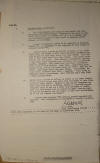
|
3.
19 May 1928.
Intelligence Period Report,
1st Lt. W. C.
Hall, Puerto Cabezas, p. 3.
" . . . 7.
MISCELLANEOUS
(continued) ¶ b. The above
remarks also apply to the report that
arms are being sent from Honduras.
Practically the whole of the WANKS
(COCO) river is covered, and it is not
believed that any considerable amount of
arms could be smuggled across without
our knowledge. ¶ c. A copy
of Sandino’s letter to Mr. Amphlett is
attached, marked ‘A’. A photograph
of the signature to this letter is
attached marked ‘B’. ¶ d.
Captain Edson reports as follows on
trails in his area: ‘CASA VIEJO and
BODEGA on EULI Creek identical (Moravian
Map). From Musawas to Casa Viejo
about four days travel. From
Neptune to CASA VIEJA about four days
travel. Both trails mountainous and hard
going. Time estimate conservative.
NEPTUNE – CASA VIEJA trail reported good
condition with considerable traffic.
MUSAWAS – CASA VIEJA fair condition.
Information trail south of line PIS PIS
– CASA VIEJA – BOCAY very poor.
Believe trail from LA LUZ north along
ULI river – head PIS PIS Creek – CASA
VIEJA about five days travel.
Unconfirmed, believe trail southwest
CASA VIEJA – AKARTULU – BOCAY river to
MATAGALPA Trail, unconfirmed. Well
traveled trail CASA VIEJA – BOCAY
leading west.’ ¶ e. Captain
Rose reports as follows on trails in his
area: ‘Patrol to ASA confirms report
that trail runs from WUANI to CASA VIEJA
along ULI River basin.’ ‘Patrol to
ALO reports overgrown unused trail from
ALO to CUINCUINA. Patrol to
CUICUINA reports overgrown trail to ALO
and a trail from CUINCUINA to CASULI.
Have this date established an outpost at
WUANI covering trail to ASA and
triangular out off trails of main road
from MATAGALPA to PIS PIS running
through WUANI.’ ¶ f. Captain
Rose reports: ‘Two Mexican generals
reported with Sandino’. This
information is considered of doubtful
reliability. ¶ W. C. HALL, ¶
Area Intelligence Officer."
|
|
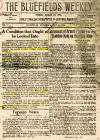
|
1.
19 May 1928.
Bluefields Weekly, p. 1.
"STATEMENT OF ARTURO PINEDA EN
RE SANDINO RAID ON BONANZA MINE
¶ Bluefields, Nic. May 12, 1928. ¶
ARTURO PINEDA , a native of Nicaragua
resident of Bluefield, 27 years of age
and unmarried, being sworn according to
law deposes and says that for some time
he has been in charge of the commissary
at Neptune Mine the property of Bonanza
Mines company, situated in the mining
district of Pis Pis, Department of
Bluefields, Republic of Nicaragua. ¶
That at 2 o’clock Sunday morning April
19, 1928 a special messenger from La Luz
Mine brought the news that Sandino’s
army had looted said mine and was on its
way to Neptune, thereupon the Inspector
of Police, the Superintendent of the
mine with the other employees and
workmen of the mine(with the exception
of myself, Fred Delft (German) and five
colored men) not waiting for the arrival
of the soldiers to reach the mine at
about 8 a.m. ran to the bush for safety.
¶ That a detachment of Sandino’s army
numbering about 200 men on horseback
under command of General Manuel M. Giron
R. reached Neptune mine at 3 p.m.
Sunday, April 16, 1928. ¶ Colonel
Rodriguez, who had command with (?)
inquired ? of me in Spanish where the
Americans were. I told him there was
nobody here but me and I was in charge
of the place. Then two soldiers searched
my person after which the Colonel asked
me if the company had any arms and
ammunition. I told him that Mr. A.H.
Head must have taken same. ¶ Then he and
some soldiers went to the comandancia
and searched the place finding a few
rifles, the property of the Nicaraguan
government that were there for the use
of the Police Inspector. They then asked
me where was the Inspector of Police and
the employees of the mine. I answered
that they left early in the morning on
their way to Bluefields. ¶ At this time
General Giron with his staff arrived and
immediately asked for me and ordered me
to open the Commissary and show him
around which I did. ¶ He went up to my
room first and when I opened my trunk
for examination he found ten shells for
a 35 calibre rifle, the property of the
company which he took. ¶ Then we went to
Mr. Hansed’s (Norwegian) room who was
sick and in bed and while the General
was questioning him the soldiers took
his watch, fifty dollars in cash, a rain
coat and a pair of lace boots. General
Giron made no effort to restrain them
from this robbery. ¶ A visit was next
made to Mr. Napoleon’s room and after a
fruitless search for ammunition and arms
a rain coat was all they took therefrom.
¶ Next was Mr. Warnick’s room the
President of the company who at that
time was in Philadelphia, Penna. They
asked for the keys to his trunk and two
valises and as I did not have them the
lock of the trunk was broken where a 45
calibre colt automatic pistol was which
they appropriated. ¶ Our next visit was
to the office where a general search was
made finding another 45 calibre colt
automatic pistol which was confiscated.
¶ I was then asked for the combination
of the safe which I did not have. The
General then sent for Mr. Delph and
another mechanic who at the order of the
General broke the hinges and the
combination and got some ammunition for
the two pistols. ¶ Then on to the
Commissary and while the soldiers were
helping themselves to anything they
wanted the General called for Mr. Delph
and asked him how much gold was in the
boxes, his reply was he did not know.
The General sent for two black men John
McPherson and Felipe Bernard and asked
them to melt the gold and he would pay
them. He wanted the gold to be ready on
Monday afternoon before dark, which was
done and the amount of bullion taken was
344 ½ ounces he giving me a receipt
therefor. ¶ The soldiers under command
of Colonel Sanchez and General
(continued on Page Six) . . . [NOTE:
Continued on Page 4, below]
---------------------------- ¶
A CONDITION THAT OUGHT TO BE
LOOKED INTO. ¶ According to
information received from Puerto
Cabezas, conditions with regard to the
large number of unemployed is beginning
to reach the proportion of a problem, a
problem that our government ought to
turn its attention to ere some serious
happenings result. One can scarcely
measure the possible excesses a hungry
multitude may indulge in. ¶ It would
appear this state of affairs have been
brought about, if not totally, at least
to a great measure through the methods
employed by unscrupulous captains and
ship owners, who go to the extent of
propagating the ridiculous and highly
misleading idea abroad that at Puerto
Cabezas the dollar can be picked up on
the streets and paths, so to say, and so
deceive the unwary into procuring by any
means at their disposal, the value of
their passage (?) (?) (?) to find an
order of things very much the (?) to
exist in the average field on this orb.
¶ As it most always happens, whenever
people get to learn of some new
development in a given locality they
begin to flock to such a place, whatever
might be their calling life,--even
professionals without every stopping to
think or enquire what might be the sort
of hands most required. As a result they
often find themselves completely out, as
touching their particular line, then are
forced to enter services they are wholly
unfit for, with the consequent
upshot—they are discharged and as
someone must carry the blame the
developing company is made to bear it,
then the ensuing want and sickness crown
the climax. ¶ Taken into hands atone
this fast forming problem of Puerto
Cabezas can be easily straightened out,
but if the conditions leading to it are
allowed to continue, our government may
soon find itself face to face with a
situation not easily adjusted. ¶ The
situation ought to be put under control
without delay. It would be well, also,
for the representatives of the countries
whence come this inordinate influx of
work-hunters to take an interest in the
matte and give their governments the
necessary warnings."
|
|
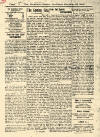
|
2.
19 May 1928.
Bluefields Weekly, p. 2.
"The
Coming City" [on the growth of
Puerto Cabezas.]
|
|

|
3.
19 May 1928.
Bluefields Weekly, p. 3.
"An
attack on Sandino. ¶ The
resolution made by the Junta
Departamental y Legal del Partido
Liberal Nacionalista is a step in the
right direction of which there is still
some distance to be traversed. ¶ While
sentimentally some of us may be
Sandinistas,-- if just a wee bit; with
all these outrages being committed, it
must be admitted that it is no time for
sentimentality. We must look at the
thing in a reasonable light. ¶ If we sum
up some of the characteristics of the
man Sandino, what do we find? ¶ The
world knows that Marines were called by
the present government when they were in
the peril of being overthrown by the
revolution. That some months later, both
the government and the revolutionaries
agreed to cease hostilities on the
grounds of the renown Stimson agreement.
¶ At this termination of affairs Sandino
revolted against his leader, showing at
once his disloyalty. In his “patriotism”
overestimated at home and abroad, he has
been found wanting. Can anyone who
destroys properties of his poor
countrymen, and of rich foreigners who
are here to develop his country, be
called patriot? ¶ Let us suppose that
Sandino was successful in some agreement
whereby he would cease his brigandage;
he has already hinted that he would want
to dictate who should be president.
Would that be republicanism? Or perhaps
he would want to be acclaimed president
himself, a position for which, barring
all other qualities required, he has not
the least capacity. ¶ We have enough of
tyrants, dictators and oligarchs; let us
embrace the chance of a republican form
of government—via the polls, with the
disinterested outsider as referee. ¶ As
citizens of this country, without
distinction of political colour, we are
morally compromised to cooperate with
the American Marines here; for while
they are in power, that does not make
them any less our guests and as such we
are ethically obligated. ¶ It is a well
known fact that the majority of the
laboring class is unlettered, hence
these do not get any benefit from the
good work being done by the press. Now,
I have found that most of these , men
expressing themselves sympathetically
toward Sandino and are in the (?) with
their expressions about the Marines, but
as soon as they are shown that the
marines are here for their’s (sic) and
the Country’s benefit they are
converted. ¶ Why have the political
parties ignored this? What is the urban
organization known under the name of
Liga Costeña doing? Why do not they
organize local committees for propaganda
work, especially in denouncing Sandino’s
robberies and promoting the spirit of
cooperation with the Marines? The
Marines can also reciprocate; (?) there
have been instances of note were the
Marines have dealt too rashly with civil
offenders, but the instances are getting
fewer, due perhaps to the officers
getting on at last to the psychology of
our mixed population . . . ¶ Let us work
together, not only for free election and
republican government, but towards a
better Pan-American understanding."
|
|
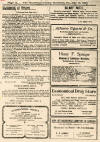
|
4.
19 May 1928.
Bluefields Weekly, p. 4.
"Statement
of Arturo Pineda . . . (continued from
Page One) ¶ . . . Giron in the
meantime ate, drank and gave out things
in the Commissary to a lot of
stragglers. All with the exception of 20
soldiers left at midnight for Lone Star
where they had a camp. ¶ On their way
from La Luz Mine the army stopped at
Lone Star, subsequently coming to
Neptune Mine. ¶ Before the General left
he gave me orders to leave the doors of
the Commissary open and to let everybody
have what they wanted; saying because it
was American property they wanted to
destroy everything belonging to the
Americans, this was said in the presence
of the soldiers. ¶ The 20 remaining
soldiers had instruction to see that the
people got everything they wanted from
the Commissary by order of General Giron
and they made a clean sweep of the
contents. ¶ Monday the 16th orders came
from General Giron to send some
provisions to Lone Star Mine and to get
enough flour to bake bread for the
soldiers and stragglers which was done
by me. ¶ At eight o’clock Tuesday
morning the 17th General Giron came from
Lone Star Mine (abandoned) which is
about two miles from Neptune and asked
me how much powder (dynamite) was on
hand and he was told about sixty cases
which he took making three piles thereof
and burned it up. ¶ After eating
breakfast they put a case of dynamite
into the Ball Mill and blew it up using
25 feet of fuse to enable every one go
get out of danger so as to avoid killing
or injuring any person when the dynamite
exploded, after this performance they
departed for Lone Star Mine. ¶ In the
meantime the General sent three soldiers
to Panama Mine accompanied by Andres
Leiva and Ascension Figueroa where the
Company’s mules were in hiding and
helped themselves to six taking a pistol
from Wederburn then to the Bodega
(Warehouse) at Aguas Calientes taking
all the merchandise there then for Lone
star with their (sic) plunder. At the
same time taking Jose Moncada along to
care for the mules. ¶ About six p.m.
Sunday April 29th another contingent of
some 80 soldiers under command of Marcos
Aguero came to the mine and took from
the Commissary whatever was left and
departed in the direction of Waspook
river. ¶ And further deponent sayeth
not. ¶ ARTHUR M. PINEDA ¶ American
Consulate, Bluefields, Nicaragua ¶ Sworn
to and subscribed by ARTHUR M. PINEDA,
before me at the American Consulate,
this the 12th day of May, 1928. ¶ SAMUEL
FLETCHER ¶ Service No. 128. ¶ Consul of
the United States of America at
Bluefields, Nicaragua ¶ RECEIPT OF
GENERAL GIRON R. ¶ BONANZA MINES COMPANY
¶ Mr. Arthur Pineda was directed to
place at the orders of the forces of the
Liberator whatever may be necessary for
its sustenance and as this property
belongs to Americans who are the cause
of this expedition we take for our use
merchandise which we are in need of and
the existing gold which amounted to 354
½ ounces. ¶ For Country and Liberty, ¶
(Signed) GENERAL MANUEL GIRON R. , ¶
Neptune, April 17, 1928."
|
|
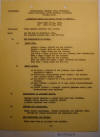
|
20 May 1928.
Operation Report and Weekly Report of
Events, 1st Lt. W. C.
Hall, Puerto
Cabezas, p. 1.
"Reference: Daily
reports covering same period. ¶
Maps: (a) Ham map of Nicaragua, 1924.
¶ (b) Moravian Mission Map, file
#B-7-12. ¶ 1.
OUR DISPOSITION
OF FORCES. ¶ a.
FRONT LINE.
¶ AWAWAS – Lieut. CARROLL and one
Section. ¶ WASPUC – Lieut.
TUFT and one Platoon. ¶
MUSAWAS – Capt. EDSON and one Platoon.
¶ SAN PEDRO – Capt. LINSCOTT and
one Platoon, less detachments. ¶
EDEN – Capt. WALKER and one Platoon.
¶ LA LUZ – Capt. ROSE and one
Platoon. ¶ Near SAN PEDRO
del NORTE – Capt. MATTESON and patrol.
¶ Near RAMA – Capt. TEBBS and ten
men. ¶ b.
OTHER FORCES.
¶ At EL GALLO – Outpost of one
platoon, less Captain MATTESON’S Patrol.
¶ At BLUEFIELDS, Headquarters
South Sector – one platoon less Captain
TEBB’S patrol. ¶ At RIO
GRANDE – Outpost of 8 men, under
Non-commissioned officer. ¶
At PUERTO CABEZAS – Aircraft Squadron
(Eastern Area); Area Headquarters; rear
echelons. ¶ 2.
INFORMATION OF
ADJACENT TROOPS. ¶ Captain
Martin reported a patrol sent east from
JINOTEGA. ¶ Captain Phipps
reported vicinity CUSULI. ¶ A
patrol reported near POTECA. ¶
3. WEATHER AND
VISIBILITY. ¶ Rainy
season commencing. Ground
conditions not bad yet. Visibility
and flying conditions for airplane poor.
¶ 4. OUR
OPERATIONS FOR PERIOD. ¶
There have been no contacts with bandits
. . . "
|
|
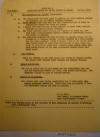
|
20 May 1928.
Operation Report and Weekly Report of
Events, 1st Lt. W. C.
Hall, Puerto
Cabezas, p. 2.
" . . . 4.
OUR OPERATIONS
FOR PERIOD. (Continued).
¶ a. 1. The entire week has been
spent in getting the five northern
patrols in position, and in getting
supplies forward. ¶ 2. Small
patrols have been sent out from
Bluefields and El Gallo to investigate
rumors and found all quiet. ¶
3. A patrol was sent out from Puerto
Cabezas to Sisin Farm, returned reported
no sign of bandit activity. ¶
4. The large patrols, while waiting for
supplies to catch up, have sent small
reconnaissance patrols forward to
investigate trails and routes of
advance. ¶ 5. The following
dispatch was sent by radio to Captain
Edson, who delivered it to Captain
Walker. It was prepared as a drop
message for the other patrols: ‘5619 D
REPEAT D DAY IS MAY TWENTY THIRD STOP
WALKER MOVES ON LAKUS STOP EDSON MOVES
ON CASA VIEJA PREPARED TO PUSH ONTO
BOCAY STOP LINSCOTT MOVES ON CASA VIEJA
STOP ROSE COVERS TRAILS LA LUZ AREA
ESPECIALLY TOWARDS HIJAS STOP UTLEY
2100’. ¶ b.
AIR SERVICE.
¶ Since the arrival of two more
planes and return of Captain Howard, the
planes have resumed their liaison and
freight flights. ¶ 5.
COMBAT EFFICIENCY.
¶ The men on patrol are in most
cases new men and probably have not yet
the experience needed for their best
combat efficiency. The airplane
flights do much to improve morale.
¶ 6. RESULT
OF OPERATIONS. ¶ The
outlaws have been forced practically out
of this area, they having retreated
before us. There have been no
reports of bandit activities behind our
line of patrols. ¶ W. C.
HALL, ¶ 1st Lieut., U.S.
Marine Corps, ¶ Area
Intelligence Officer."
|
|
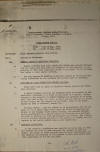
|
20 May 1928.
Intelligence Report, May 13-19,
1st Lt. W. C.
Hall, Puerto Cabezas (p. 1 only).
"Reference: Daily
reports covering this period. ¶
Maps: Ham map of Nicaragua. ¶ (A)
GENERAL STATE OF
TERRITORY OCCUPIED. ¶
a. Rumors continue that small bands of
outlaws are present throughout this
area, but they have all dispersed on the
approach of our patrols, or have been
imaginary in the first place. It
is believed the latter is more nearly
correct. ¶ b. The only
groups of bandits of any size appear to
be wholly confining themselves to the
northern and central part of JINOTEGA.
¶ (B)
ATTITUDE OF CIVIL POPULATION TOWARDS
MARINES. ¶ a. There
have been no cases of friction between
marines and civilians reported. ¶
b. A native boatman going up the
CUCULAYA River was wounded by the
accidental discharge of a rifle in the
hands of a marine. He was brought
to the hospital in PUERTO CABEZAS and
appeared to be doing well, but died on
May 11, 1928. A small sum was paid
to his brother and sister, who are
caring for his wife. Copy of the
paper signed by them is attached, marked
‘A’. ¶ c. William Pierce, a
man who claims to be an American, but
who appears to be of mixed negro blood
shot and killed an American employee of
the Bragman Bluff Lumber Company, and
wounded another. He was
apprehended by a marine patrol and
confined as a military prisoner to
protect him from any possible mob
action. The Indians in this
vicinity gladly assisted in the pursuit
of PIERCE, and his capture by the marine
patrol made a good impression. ¶
(C) ECONOMIC
CONDITIONS. ¶ A. In
the interior, conditions are reported as
being bad, in that the bandits are said
to have stripped the country of food and
money. The truth of these reports
are now being investigated. In the
meantime the presence of our patrols in
this area should help some, especially
if the men are paid."
|
|
_small.jpg)
|
20 May 1928.
Sofonías Salvatierra, 'Difícil situación
de los Obreros en la Costa Atlántica,"
La Noticia, Managua.
[NOTE:
This is an interesting & important
analysis by one of the leading
Nicaraguan intellectuals of the 1920s
and 1930s and one of the leading
activists advocating the rights of
labor. The article merits close
attention, though blaming the widespread
poverty & unemployment & sharpening
social divisions on an "inundation"of
black West Indian laborers is highly
problematic.]
|
“Dificíl situación de
los Obreros en la Costa
Atlántica.” Sofonías
Salvatierra, La Noticia,
Managua, 20 May 1928. ¶ Nos
dicen de Bluefields los
siguientes dolorosos informes: ¶
“En Puerto Cabezas se presente
hoy quizá el problema más
difícil para el obrero nacional,
pues en ese lugar ha sido
barrida la mayor parte de
empleados nicaragüenses y
repuestos con negros antillanos.
Diga Ud, pero de una manera que
todo el mundo lo sepa, lo
inconvieniente que es para el
pobre jornalero del interior
engancharse para los trabajos de
Puerto Cabezas. Esos infelices
son tratados como bestias, sin
ninguna oportunidad de mejorar
su condición, las enfermedades
se han cebado en ellos y muchos
arrastran su miseria en las
calles de esta ciudad de vuelta
de lo Siberia nicaragüense.
Siberia, si, para los que hemos
tenido la dicha de nacer en este
bendito país. Paraíso para
yanquis y negros de todas las
clases. No menos de dos mil de
estos últimos han desembarcado
en estos días. Cabe preguntar al
estos individuos traian las cien
pesos que manda la ley." ¶ Hasta
aquí los aterradores delos que
se nos han enviado ¿Qué dice de
esto pueblo nicaragüense, que
dispone el Gobierno de la
Nacion? Nicaragua está alendo
inundada de negros antillanos
para sustituir con ellos al
obrero nativo, al ciudadano de
la República, al propio dueno de
esta tierra. Nosotros queremos
estar convencidos de la buena le
de los enganchadores de
operarios para los trabajos de
la Costa Atlántica; ellos
seguramente no conocen las
intenciones ulterior de la
Compañía que las solicita.
Nosotros hemos visto la formula
de los contratos que firmen los
obreros que ofrecen irse para
Puerto Cabezas. Esos documentos
no llenen la forma bilateral que
es debido, sino que es una
simple declaración que el
enganchado hace. Ni la Compañía
patrona, ni ningún representante
suyo los firme. ¶ El Organismo
Local de Bluefields del
Obrerismo Organizado de
Nicaragua acabo de despachar un
delegado a Puerto Cabezas, y
pronto tendrémos informes más
completes sobre este asunto. ¶
No hay palabras con que
encarecer, con que evidenciar al
obrero nicaragüense la necesidad
fundamental que tiene de
organizarse, para la defensa de
los múltiples derechos que posee
en esta su patria declarada
libre por los próceres de la
independencia hace ciento siete
años. También no hay palabra con
que convencer a políticos y
empresarios de la conveniencia
general que enrana el que a los
no calorban este proceso
organicisia de la inmenso masa
trabajadora, principle social
indispensable para la
constitución de la República y
para el recio desenvolvimiento y
goce legítimo de las energias de
todos. ¶ Urge que se proclama
por todos los rumbos de la
conciencia nacional y a la luz
de todos los intereses, que el
hombre trabajador no es cosa,
sino persona; que el trabajo del
obrero no es un utensillo en las
empresas, como lo es la
herramienta, lo material prima,
las tierras, sino un factor
social de la producción y el
consume, igual en dignidad e
intereses con el capitalista.
Este concepto eminentemente
humano es el fruto triunfal del
cristianismo, y de todas las
revoluciones libertadores del
siglo diez y nueve. ¶ No podemos
comprender cómo se puede no dar
buen trato y consideración al
que con su trabajo aumenta
nuestros haberes. Esto no quiere
decir de ningún modo que le
obrero falta a los deberes de su
contrato. Por eso la
organización obrera debe ser en
forma cooperativa en presencia y
respeto equiliativa de los otros
intereses sociales. ¶ Por lo
pronto, en la Costa Atlántica
hay centenaries de desheredados
y desgraciados obreros, hilos de
nuestra patria, que caian
esperando el socorro de su
gobierno. La ayuda debe ser
prestada inmediatamente por
deber gubernamental
imprescindible, siquiera por
humanidad. ¶ Obreros de
Nicaragua: organizarse, ahorrad,
instruios, si queréis ser pueblo
libre. ¶ SOFONÍAS SALVATIERRA,
Managua, 19 de mayo de 1928."
|
|
|

|
21 May 1928
(0500, 0710, 0900).
Radiograms from Capt. M. A. Edson, Wanks
Patrol, to Major H. H. Utley, Puerto
Cabezas.
|
|

|
21 May 1928
(1600).
Radiogram from Capt. Rose, Prinzapolka
patrol, to Major H. H. Utley, Puerto
Cabezas, p. 1.
|
|

|
21 May 1928
(1600).
Radiogram from Capt. Rose, Prinzapolka
patrol, to Major H. H. Utley, Puerto
Cabezas, p. 2.
|
|

|
21 May 1928
(2035).
Radiogram from Major H. H. Utley, Puerto
Cabezas, to Gen. Feland, Managua (copy
to Edson, Wanks River Patrol).
|
|
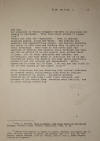
|
21 May 1928.
Excerpt of letter from
Capt. M. A. Edson
to sister (from the notes of David C.
Brooks).
|
|
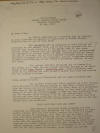
|
22 May 1928.
Letter from Major Hans Schmidt, Managua,
to Major H. H. Utley, Puerto Cabezas, p.
1.
"My dear Major:
¶ Am taking advantage of a
possible trip by Aviation in your
direction to explain a little more in
detail General Feland’s wire to you of
this date. ¶ The Marshall
case is occupying a great deal of our
attention at the present time, and we
are being pressed with inquiries from
every source as to the latest news in
that case. General Feland desires
that you impress upon all your
subordinates the necessity of gaining
early and full information and of
transmitting it promptly. All of
your advanced elements should be
particularly impressed with the
necessity, and all operations should
consider the effecting of his rescue a
secondary mission, to say the least.
¶ The general military situation
may be stated in a few words, i.e., that
the main bandit strength appears to be
localizing in the Pena Blanca –
Bocaicito Area. While proceeding
west about 13 May bandits ran into
Hunter’s patrol with what sad results
you are already familiar. ¶
Lieutenant Ridderhoff had two small
contacts hear Murra about the 15th.
¶ The article translated below
appeared as a New Orleans cable dispatch
in the Managua papers of this date.
Please investigate its source and let us
know what you find. There is a
possibility that some of the newspaper
correspondents on that coast had
something to do with it. Possibly
Benny or Haas may know something about
it. The Cuyamel Fruit Company
which has its headquarters in New
Orleans may also know something.
It is desired of course that this
information be procured without letting
anyone know that we are concerned about
the criticism. ¶ ‘THEY KNOW
WHAT THEY ARE DOING’ ¶ ‘New
Orleans: Prominent North Americans
who have interests in Nicaragua have
addressed the Navy Department in
Washington, saying that for some weeks,
knowing the plans for attack of the
Marines in Nicaragua, that they are not
in accord with said activities because
there has not been made the distribution
necessary to round up the Sandino
rebels, who always have good exits into
the mountains and take other directions
in order to reorganize and devote
themselves to violences. According
to the New Orleans Evening (paper) the
terrain of Nicaragua is not as difficult
as the Riff region of Morocco, where
French and Spanish . . . "
|
|
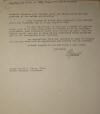
|
22 May 1928.
Letter from Major Hans Schmidt,
Managua,
to Major H. H. Utley, Puerto Cabezas, p.
2.
" . . . aviators
obtained good results about two years
ago in the subjugation of the outlaw Ab,
del-Krim.’ ¶ Your request of
recent date concerning the Standard
Fruit and steamship map is being
complied with. ¶ We are
endeavoring to keep you informed of
anything which goes on in this area,
which we believe to be of immediate
importance. Less important matter
will be sent by mail. The B-2
Report should give you an idea of the
operations being conducted and of the
information being received. ¶
Any suggestions from you relative to
ways of helping you in your area will be
appreciated and carried out if possible.
¶ Kindest regards to you and those
I know there. ¶ Sincerely,
¶ H. SCHMIDT"
|
|

|
22 May 1928
(0900).
Radiogram from Capt. M. A. Edson, Wanks
Patrol, to Major H. H. Utley, Puerto
Cabezas.
|
|

|
22 May 1928
(1152).
Radiogram from Gen. Feland, Managua, to
Major H. H. Utley, Puerto Cabezas.
|
|

|
1.
22 May 1928.
Letter from Capt. M. A. Edson, Musawas
on the Rio Coco, to son Austin
(photocopy of original with marginal
notes by David C. Brooks), p. 1.
[transcribed
in full below, starting page 8]
|
|

|
2.
22 May 1928.
Letter from Capt. M. A. Edson, Musawas,
to son Austin, p. 2.
[transcribed
in full below, starting page 8]
|
|

|
3.
22 May 1928.
Letter from Capt. M. A. Edson, Musawas,
to son Austin, p. 3.
[transcribed
in full below, starting page 8]
|
|

|
4.
22 May 1928.
Letter from Capt. M. A. Edson, Musawas,
to son Austin, p. 4.
[transcribed
in full below, starting page 8]
|
|

|
5.
22 May 1928.
Letter from Capt. M. A. Edson, Musawas,
to son Austin, p. 5.
[transcribed
in full below, starting page 8]
|
|

|
6.
22 May 1928.
Letter from Capt. M. A. Edson, Musawas,
to son Austin, p. 6.
[transcribed
in full below, starting page 8]
|
|

|
7.
22 May 1928.
Letter from Capt. M. A. Edson, Musawas,
to son Austin, p. 7.
[transcribed
in full below, starting page 8]
|
|
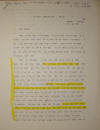
|
8.
22 May 1928.
Transcription of letter from
Capt. M. A.
Edson, Musawas, to son Austin (with
marginal notes by David C. Brooks), p.
8.
"Dear Austin:
¶ What do you think of this paper?
It is all I have and not much of it
either. I got your letter about
the big tooth the day before I left
Waspuc. It was a nice letter and I
was glad to get it. Wasn’t it fun
to have the tooth pulled? And
don’t you like Dr. Partridge? You
are getting to be such a big man now,
going to school every day, sliding,
skating, having teeth pulled and
everything, aren’t you? ¶
When we left Waspuc to come here, what
do you think we need? Boats!
And such funny boats. Here is the
way the Indians make them. They go
into the woods and find a great big
(picture of tree). Then they take
an (picture of axe) and cut it down.
They take the longest and straightest
and biggest piece of the tree home with
them. Then they use different kind
of an axe which looks like this (picture
of axe) and then dig out the wood from
the center of the (picture of log).
Sometimes they build a (picture of fire)
in the log as they do not have to cut as
much with the (picture of axe).
After about five days work, the log
looks like this (picture of boat) and
that is the boat. They are very
good boats, too, because they are easy
to paddle or push with a pole and if one
sits quite still, do not tip over easily
even though sometimes the water may come
over the edge. In each boat were
three Indians in the bow and one in the
stern. The three in the bow had
long, light poles which are very strong
and do not break easily. With the
poles they push the (picture of boat)
where it is shallow and up through the
swift places in the river. They
can push a boat through places that we
would have to . . . "
|
|
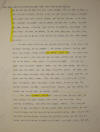
|
9.
22 May 1928.
Transcription of letter from
Capt. M. A.
Edson, Musawas, to son Austin, p.
9.
" . . . get out
and pull the boat through with a rope
because they are used to doing it, and
if I tried it I would fall out. A
few days ago I did try to pole a little
bit through a short rapid and I lost my
balance and fell out. The man in
the stern had a [drawing of a
paddle] and he steered the boat
with it. When the water was deep
the man in the bow used [drawing of
a paddle] too because their poles
would not touch the bottom. At one
place there were big falls in the river,
so we had to get out of the [drawing
of a boat] and carry them around
the falls. ¶ On both sides
of the river are lots and lots of trees.
In the trees I saw all kinds of things.
Do you remember the [drawing of
bird] I told you about which has so
many bright colors—the MacCaw bird?
There are a great many of them up here
in the trees, and they are much prettier
than the one that was on the Denver.
They always fly in pairs, the mama bird
and the daddy bird are always together.
Maybe you have seen another bird with a
large nose, that people keep and teach
to talk—the parrot? The woods here
are full of them, too, green ones, blue
ones, and many colored ones—but the
green ones are more common. They,
too, always fly in pairs, but a lot of
them fly together, while the macaw birds
usually fly two by two. The
parrots certainly can make a big
noise—each morning and each evening they
screech and cry and wake up everyone
around. ¶ Then there is
another bird which flies in a tree.
His nest looks like this [drawing of
a pouch handing from branch and bird
below. Arrow pointing to something
that looks like a hanging beehive, ‘This
is the door where he goes into house.’]
He has a glossy black coat of
feathers and the tip of his wings and
the tip of his tail are a bright yellow.
When he sits still he looks like this
[drawing of bird]. He is
all black except just the tip of his
wings, and of his tail and his beak or
bill, which are bright yellow. But
when . . . "
|
|
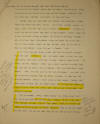
|
10.
22 May 1928.
Transcription of letter from
Capt. M. A.
Edson, Musawas, to son Austin, p.
10.
" . . . he flies
this his tail feathers spread open and
appear to be all yellow instead of just
the top of it. He has a nice song,
too, and his name is ‘Oriole.’
There are a great many of them in the
woods and along the river. ¶
Besides these, one sees bright red
cardinals, blue birds, many colored
birds, king fishers, and nearly every
one of them is bright colored. In
a banana grove a few days ago I saw a
[drawing of hummingbird] like
this. He is only two and a half
inches long, about as long as mother’s
middle finger, and he has a bill almost
as long as himself. He flies up to
the banana blossoms, puts his bill way
down to the bottom of one and drinks out
all the honey, then he flies to another
flower and does the same thing, all the
time he keeps up loud humming noise.
His name is ‘humming bird’. ¶
The trees, too, have things in them that
look like [drawing of monkey]
this. Their name is ‘Monkey’.
Some are reddish brown all over, they
make a big howling noise which gives
them the name ‘Howling Monkey’ –
although the Indians call them
‘Baboons’. Other have a white face
and a big dark brown body, and they are
smaller than the baboons. They are
called ‘white faced Monkey’. When
the boats go by up the river, the
monkeys run along in the tops of the
trees, swinging from one branch to
another by their arms and tails, and
sometimes making a chain of two or three
monkeys holding each other’s hand to
swing over the longest places. All
the time they chatter and screech at us
as if they were asking what right we had
in their woods and telling us to get
out. ¶ You are probably
asking if these Indians live in tents,
aren’t you? They do not use tents,
but lean-tos when stopping for only a
few days. These lean-tos are made
like this. Four bamboo poles are
cut and tied together at the top
(picture of triangle structure).
Then on the side towards the wind where
the rain will come, they put up a roof
or a wall of leaves . . . "
|
|
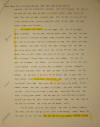
|
11.
22 May 1928.
Transcription of letter from
Capt. M. A.
Edson, Musawas, to son Austin, p.
11.
" . . . something
like this [illustration of previous
with wall of leaves]. The
floor is the sand, and their beds are
made of big green banana leaves laid on
the sand. Then they put down a
blanket made from the bark of a tree,
and that is their sleeping plan.
It is not a bad bed either, for your
Daddy has slept several nights just like
that. ¶ The Indians real
houses, though, are bigger. They
just cut big bamboo poles or mahogany
and put them into the ground where they
want the house to be, like this
[illustration of frame, looks like table
without top]. Then they put a
roof on the house like this
[illustration of frame from before with
peak roof. Standard type frame for
one room house of logs]. Then
they make a roof of big coconut palm
leaves which they tie onto the roof.
Some of the houses have no walls.
Others have walls on the rainy side and
some have walls all around like our
house, with doors and windows. The
walls are made out of bamboo, too,
(Mother will tell you what that is) only
they split it with machetes so that it
is flat. This is a machete,
[drawing of machete], just a great
big bread knife. The doors are
made of split bamboo, too. The
windows are just holes in the wall, for
the Indians have no glass, and all their
cooking is done in big black iron
kettles. Here is one of them
[drawing of iron kettle].
They make their fires right on the floor
in the middle of their houses, because
they have no stones at all. When
they bake anything, they just make a big
fire so as to have a great many coals
then they wrap their bread in a big
green banana leaf, and then put it into
the coals all covered up with the coals,
and leave it there until it bakes.
When they take it out of the leaf, it is
all brown and crispy and not burned at
all. ¶ All the people go to
bed early because they have no electric
lights or any lamps, and they also get
up very early in the morning, always
before the sun peeps up over the trees.
But they are very lazy people, too.
They live on . . . "
|
|
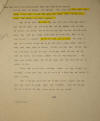
|
12.
22 May 1928.
Transcription of letter from
Capt. M. A.
Edson, Musawas, to son Austin, p.
12.
" . . . rice and
beans and bananas, and sometimes they
catch fish. They work just enough
to buy their rice and they grow only
enough beans for the rainy season.
The bananas are always growing. ¶
How do you think they fish? Two
men get in one of the small boats I have
told you about. One sits in the
back end and paddles, ever so slowly and
so very, very quietly that no one can
hear him, not even the fish in the
water. The other man stands in the
front end of the boat. What do you
think he has? A fish pole?
No, he has a bow and an arrow. The
arrow is made out of a piece of reed and
on one end it has a large, slender piece
of round wood, made sharp by burning it
in the fire. Then when the man
sees fish in the water, he puts the
arrow on the bow, bends the bow, and the
other man moves, oh so slowly, towards
the fish. Then—twang—and the arrow
goes straight toward the fish and spears
him! And that’s the way he catches
his fish. ¶ Pretty soon you
will have a birthday. Mother will
have to spank you for Daddy, I think,
don’t you? You will write me a
letter then and tell me all about it, I
know. ¶ Here is lots of love
and all these kisses. I would send
you more only I have not enough paper.
And tell Mother I love her, too, and
give her a big hug and some kisses for
me, will you, please? ¶
Daddy. ¶ xxxxxxx (etc.)"
|
|

|
23 May 1928
(1000).
Radiogram from Capt. M. A. Edson, Wanks
Patrol, to Major H. H. Utley, Puerto
Cabezas.
|
|

|
23 May 1928
(1400).
Radiogram from Capt. Walker,
Waspuc, to
Major H. H. Utley, Puerto Cabezas.
|
|
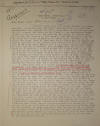
|
23 May 1928.
Letter from Major D. J. Kendall,
Wide Water,
Virginia, to Major H. H. Utley, Puerto
Cabezas, p. 1.
"Dear Major Utley:
¶ I arrived home here last Sunday
morning and found both Rita and little
Dominick abed. When the radio was sent
from Headquarters, they thought that
Rita would have to have an operation for
gallstones. But later on they found it
was congestion caused by malaria brought
on by the trip and the change of climate
that was causing the trouble to both
herself and the youngster. Now the boy
is up and around apparently all right
again and Rita is up around the house.
Both of them have lost a great deal of
weight and have no appetite so are
gaining very slowly, but still I think
they will be OK again soon. When I left
I took everything I had except my books
and papers thinking that possibly Rita
was in for a long drawn out illness of a
serious nature and I might have to try
and get duty in the States to be near
her if it was real serious. Then again I
had a lot of stuff with me that I didn’t
need in Nicaragua and I thought it would
be a good chance to get it home.
Everybody here says they should think I
would try and stay in the States seeing
that I have over 18 months in the
Tropics but I have no idea of trying to
stay here and expect to come back on the
Cuyamel ship leaving New Orleans June
16; I arrived in New Orleans May 18. ¶ I
didn’t have much of a chance to discuss
the situation in Bluefields with Tebbs
but it would have been useless anyway
and would have just mixed him up to try
and tell him so much at once. So I just
turned over the personality reports to
him and told him about a few of the more
troublesome ones and introduced him to a
few of the more dependable natives. I
had a lot of irons in the fire that I
hated to leave but figured that if it
was serious enough for headquarters to
offer me the leave I couldn’t very well
refuse to take it. Had a native over in
Pearl Lagoon working on the guns there
and another working up in Chontales.
Both of them were good men and should
have been able to get the dope if anyone
could as they were both liberals
although loyal to me I think as I had
done a great deal for both of them and
had agreed if they could find out where
the guns were to get them without
injuring the liberal party or any of
their relatives. They were both related
to the people I believed were handling
the guns hidden in the two localities.
Also would have been able to make it
worth their while financially if they
got me information as to the location of
the guns because the conservatives in
Bluefields repeatedly offered me to
suitably reward anyone I indicated that
would give me valuable information
leading up to the seizure of large
quantities of arms. I made arrangements
before leaving for natives who spoke
English to take the two men in to Tebbs
if they returned with any valuable
information and also told Tebbs who the
Marines in the Bluefields detail were
that would be best qualified to take the
patrols out in the two localities to get
the guns if the information came in . .
. "
|
|
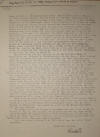
|
23 May 1928.
Letter from Major D. J. Kendall,
Wide Water,
Virginia, to Major H. H. Utley, Puerto
Cabezas, p. 2.
" . . . When I
wrote so pessimistically about the
Marines Club I thought you had several
hundred more marines at the Port than
you really had. I was discouraged
because I had such a devil of a time
getting stock as people didn’t ship
after I had ordered it in plenty of
time. I got disgusted trying to get
cigarettes from Panama and radioed
Liggett and Myers in New York to ship me
a standing order every month and have as
reference my business with them while in
Santo Domingo and got a reply that next
day saying they had entered the
Chesterfields and a gross of Ranger
tobacco that same day. That will clear
up the cigarette difficulty and if you
have made no other arrangements and
still want to the club to handle the
supplies I can insure our getting better
service on the rest of our supplies.
Please have somebody drop me a line to
New Orleans care Cuyamel Fruit Co. and
let me know about this so I can get the
letter there on my way back and fix
things up there to get more prompt
shipments if you want the club to
continue. ¶ My brother in law Hal
Turnage is on the Material Desk in
Operations on Training at Headquarters,
Marine Corps. From talking with him it
seems that the bars are down and that
anything any Commanding officer in
Nicaragua wants in the way of materials
he gets. I think you are going to get
the ambulance alright. He seemed
surprised that we only put in for four
Thompsons on the East Coast as they put
in for and got 200 of them in the
interior. He says there is all kinds of
ammunitions on hand for all kinds of
weapons now. They are developing at
tracer bullet for the 45 ammunition
which is very good. They have asked for
that in the interior, also for
pyrotechnics with which aeroplanes can
be signaled in the day time. They are
going to ship the 45 cal tracers for use
in the Thompson for that or if they are
not practical will ship a parachute
smoke bomb. He said that they didn’t
really know what kind of ammunition we
ordered in the different stations as the
weekly reports did not specify in
detail. I gathered from his conversation
that if we specified on our weekly
reports just what ammunition we had they
would supply the kinds we were lacking.
For instance at Bluefields we always
said 150 rounds 37 mm. Now if they had
known that none of that was high
explosive they would have shipped some
probably. He also asked me if we didn’t
have any Stokes Mortars? ¶ Have felt so
rocky myself and with my family sick
haven’t gotten up to Headquarters yet
but expect to go this week in case Maj.
Keyse wants to ask any questions about
conditions there. The American Consul in
Bluefields also asked me to go to the
State Department for the same reason. ¶
Gen McCoy is in the States to organize
his staff and return to Nicaragua July
6. They wanted 40 officers and 400 men
that could speak Spanish but
Headquarters at last account had found
only Maj. Price and Capt. Best for
officers and two instructors for
enlisted from the N.C.I. who could speak
Spanish. ¶ Hope the above ‘information’
will be of some use or at least
interest. ¶ With best wishes, ¶
Kendall."
|
|

|
25 May 1928
(1600).
Radiogram from Capt. Matteson,
El Gallo,
to Major H. H. Utley, Puerto Cabezas.
|
|

|
25 May 1928
(1730).
Radiogram from Capt. Matteson,
El Gallo,
to Major H. H. Utley, Puerto Cabezas.
|
|
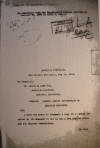
|
1.
26 May 1928.
"Sandino Admits Destruction of American
Property," letter from
US Consul S. J.
Fletcher, Bluefields, to US Minister
Eberhardt, Managua, p. 1.
"SIR: ¶ I have the
honor to transmit a copy of a letter
received by the manager of the La Luz y
Los Angeles Mines and its English
translation . . . "
|
|
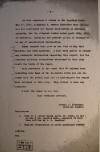
|
2.
26 May 1928.
"Sandino Admits Destruction of American
Property," letter from
US Consul S. J.
Fletcher, Bluefields, to US Minister
Eberhardt, Managua, p. 2.
" . . . In this
consulate’s letter to the Legation dated
May 17, 1928, paragraph 4, rumors
indicated that Sandino had not
sanctioned the wanton destruction of
American property, but he attached
letter dated April 29th, 1928, if
authentic, indicates the present policy
of Sandino to be one of unrestrained
destruction. ¶ Rumor reached this port
on the 22nd of May that Marshall had
been murdered. I have been unable to
secure any authentic information
regarding this report, but he American
military authorities stationed in this
city doubt the truth of the rumor. ¶
With reference to the rumors that 50
raiders were operating near Rama on the
Escondido river you are advised that the
patrol sent out to investigate the
report have returned to this city. They
failed to make any contacts. ¶ I have
the honor to be, Sir, ¶ Your obedient
servant, ¶ Samuel J. Fletcher, ¶
American Consul. ¶ Enclosures: ¶ 1. Copy
of a letter dated April 29, 1929, at the
La Luz y Los Angeles Mine, supposed to
have been written by A. C. Sandino. ¶ 2.
English translation of above mentioned
letter."
|
|
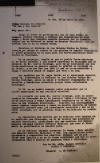
|
3.
26 May 1928.
"Sandino Admits Destruction of American
Property," letter from
US Consul S. J.
Fletcher, Bluefields, to US Minister
Eberhardt, Managua, p. 3.
|
|
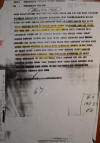
|
26 May 1928
(2255).
Radiogram from Major H. H. Utley, Puerto
Cabezas, to Gen. Feland, Managua.
|
|
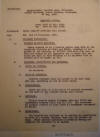
|
1.
27 May 1928.
Periodic Report, 20-26 May,
1st Lt. W.
C. Hall, Puerto Cabezas, p. 1.
|
|
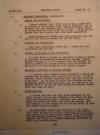
|
2.
27 May 1928.
Periodic Report, 20-26 May,
1st Lt. W.
C. Hall, Puerto Cabezas, p. 2.
" . . . 1.
MILITARY
OPERATIONS. (continued). ¶ c.
SUPPLY AND
EQUIPMENT. ¶ 1. Phipps reports
that JIRON with 80 men, armed with 30
rifles, 50 shot guns, (some muzzle
loading), and 80 pistols, and one
Thompson gun, with 200 or 300 rounds of
ammunition for each rifle and pistol. It
is not believed that the bandits have
that much ammunition. ¶ 2. Large numbers
of cattle have been reported near the
head of the northern branch of the ULI
River. ¶ d.
WEATHER AND VISIBILITY. ¶ Some
rain practically every day. Ground and
air conditions not yet bad. ¶ e.
ENEMY’S KNOWLEDGE
OF OUR SITUATION. ¶ We have lost
no papers or prisoners as far as known.
In addition to receiving information
through ‘underground’ channels, it is
believed that the bandits deduce the
coming of marine patrols from the action
of aeroplanes on reconnaissance and
liaison flights. ¶ f.
PROBABLE
INTENTION OF HOSTILE FORCES. ¶ It
appears that outlaws have continued to
avoid our patrols and probably will
continue to do so. If hard pressed,
their actions indicate that they will
move to a new area. In the area in which
the bandits are now operating, known
trails are few, but the habits of the
bandits seem to be to cut new trails in
whatever direction they mean to move. ¶
g. MISCELLANEOUS.
¶ 1. A priest who made the trip from
MATAGALPA to El GALLO stated that he was
informed that about 180 bandits were
operating from a mountain peak about ten
miles northwest of CACAO, and that the
bandits have out detours on both sides
of the Pis Pis Trail to pass and ambush
marine patrols. ¶ 2. An unverified
report was received to the effect that
three groups of bandits, totaling about
200 men, are moving up the COCO River
between BOCAY and POTECA. The
undersigned believe this report correct
and believes that JIRON is probably
operating southwest of BOCAY on the COCO
River. . . "
|
|
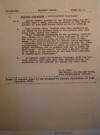
|
3.
27 May 1928.
Periodic Report, 20-26 May,
1st Lt. W.
C. Hall, Puerto Cabezas, p. 3.
" . . .
MILITARY OPERATIONS – MISCELLANEOUS
(continued). ¶ g. 3. Adrian Pineda,
employee of the NEPTUNE MINE, has
requested that a small garrison be
placed at that mine to protect it from
such roving bands at led by Arreliga. ¶
4. Base reports that: ‘Sandino when here
instilled in the mind of the natives
that if the marines came they would
rape, murder and steal.’ ¶ ‘This
insidious propaganda we are gradually
dissipating. There are a number of
former employees of the La Luz Mine who
have no food, no place to work to earn
money, and consequently are at present
barely existing. I recommend that an
immediate shipment of food for these
approximately 75 families be made, in
order to prevent actual suffering, and
to sustain them for at least the next
month. At the end of that time a general
survey to be taken to see whether or not
they have attempted to rehabilitate
themselves.’ ¶ 5. In several cases the
Hospital Corpsmen, with the various
patrols, have done good work towards
winning the confidence of the natives
for caring for their sick. ¶ W. C. HALL,
¶ 1st Lieut., U.S. Marine Corps, ¶ Area
Intelligence Officer."
|
|

|
28 May 1928
(1202).
Radiogram from Gen. Feland, Managua, to
Major H. H. Utley, Puerto Cabezas.
|
|

|
28 May 1928
(2205).
Radiogram from Major H. H. Utley,
Puerto
Cabezas, to Gen. Feland, Managua.
|
|

|
29 May 1928
(2007).
Radiogram from Major H. H. Utley,
Puerto
Cabezas, to Gen. Feland, Managua.
|
|
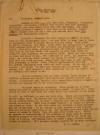
|
29 May 1928.
Patrol & Intelligence Report,
Capt. W.
W. Walker, Lakus, to Major H. H. Utley,
Puerto Cabezas.
"Arrived at nine
a.m. this date, (Tuesday). Occupation
uneventful. Conclusive evidence that
bandits were here recently. Detonators
with short fuses fixed fell into our
hands. Two woman and three children
(Spanish) only here on our arrival.
Report Ajuero stopped here one day a
week ago enroute BOCAY with five hundred
men (considered absurd). ¶ Enclosed a
document (receipt) signed by Ajuero in
March 1928 for the intelligence file.
Can make BOCAY in three days by boat. Am
patrolling river in nearby indian
villages today. Bush patrol to AKIWAS
tomorrow, May 30th. LAKUS CREEK not
navigable at present. LAKUS village
consists of one residence and outhouses
only. Believe AKIWAS, five miles west,
strategical base for extended
operations. Find that we can make BOCAY
with supplies by boat from WASPUC in
seven (7) days allowing for portage by
falls. There are four rapids on river
not shown on map. One difficult at
LAKUS, all passable with work. Am
releasing seven indians who return to
WASPUC – good men, hope ROSS can catch
as good. Rumor (hot) just came in that
Ajilero died yesterday in BOCAY. LAKUS
affords impregnable position for defense
commanding both WANKS and LAKUS creek.
We are out of smoking – all kinds. We
need pipe tobacco and cigarettes. Bull
Durham, etc. Have personally been
completely out for two weeks. Drop us
something and charge to me. ¶ Patrol
returning from up river (WANKS) found
village of SUSANWAS deserted but brought
back serviceable weapons mostly
concealed. Countryside well supplied
with ammunition, believed a number of
bandits are hanging out in the bush
hereabouts. ¶ No plans today or
yesterday. Plane passed us on river
Sunday but gave no indication of seeing
my panel, if they did. WANKS should be
open to our boats for three weeks (up
traffic) in one month it will be
difficult to make way back down. There
are absolutely no trails either side. My
patrols cut own trail ahead of boats.
There are no bandits behind us on river
– supplies may come up with minimum
escort of marines. Must keep fifteen
indians – no chance of obtaining others
up here. We see only women and children
at such villages – men are in the bush –
we are trying to make friends of the
indians. They are strongly suspicious of
us. Our boatmen have been loyal despite
rumors of enemy in front. They all came
from WASPUC area. Should we receive no
instructions to the contrary we shall
push on toward BOCAY – at present we
shall deny passage through AKIWAS and
close the river to bandits. No landing
place at LAKUS – panel station
established on arrival. Will prepare
monthly reports for pick-up tomorrow. ¶
W. W. WALKER."
|
|
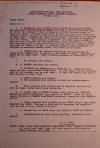
|
29 May 1928.
Field Order
No. 1, 1st Lt. W. C. Hall, Puerto
Cabezas.
"1. A. Deserters
from AGUERRO band reported 25 May that
AGUERRO was sick with tuberculosis at
BOCAY, and said to have fifteen men
only. An Indian who claimed to have
accompanied AGUERRO states he went to
BOCAY via LAKUS, arriving BOCAY about 15
May, had then about fifty men. AGUERRO
further reported as having moved up the
WANKS River in direction of SANTA CRUZ.
AGUERRO was reported as having a
quantity of supplies kind not stated.
The location of SANDINO’S (or other
bandit chief’s) Headquarters is placed
as near WANKS River above (southwest) of
BOCAY. What appeared to be a very recent
bandit camp site was observed by the
airplanes at CASCA on 26 May. A Honduran
general named MONDRAGON is reported as
marching towards BOCAY; the reason is
not known. ¶ b. WALKER with one platoon
believed to be in vicinity of TILMA
FALLS (AWAS) and is moving up the WANKS
on LAKUS. LINSCOTT and EDSON are at CASA
VIEJA. ROSE is moving westward on
MATAGALPA-LA LUZ trail. ¶ 2. We continue
our advance. ¶ 3. a. WALKER continues
his advance. ¶ b. LINSCOTT and EDSON
move on BOCAY May 30. EDSON’S report
shows two main trails CASA VIEJA-BOCAY.
If both exist, and are possible more in
two columns, one on each trail. If only
one exists, the united patrols move via
that trail. ¶ c. ROSE continues his
advance. ¶ d. The airplanes will
continue contact and reconnaissance
flights. ¶ 3. When contact with bandits
may be expected, patrols will move at
night, lying under cover during day. ¶
4. A. Supply dump at WASPUC forward 1800
rations for LINSCOTT, WALKER and EDSON
immediately upon receipt at WASPUC.
Guard for this supply flotilla to WALKER
from WASPUC garrison; thereafter from
WALKER’s patrol. ¶ b. These supplies
will probably arrive BOCAY several days
after LINSCOTT and EDSON. Rations on
hand must be conserved and supplies,
such as beef on hoof, obtained locally.
¶ c. Evacuation via WANKS River for
LINSCOTT, EDSON, and WALKER. ¶ 5.
Communication by radio where operating,
otherwise by airplanes."
|
|
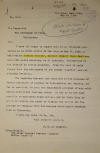
|
1.
31 May 1928.
Cable from US
Consul R. M. de Lambert,
San José, Costa Rica, to Sec. State and
Commander Special Service Squadron,
USMC, on newspaper article, "Interview
with Soldier of General Sandino, Wounded
in Arm, Tells of Fight at Calpules where
279 Women Defeated the Yankees," in
La Nueva Prensa, San José, 31 May
1931, p. 1.
[NOTE:
It is noteworthy
that none of the details of this alleged
account by Miskitu Indian Celio Martínez
correspond to any known facts (e.g.,
names & dates in the Battle of Ocotal).
This story shows every sign of being a
fabrication, Dr. Brooks' marginal notes
notwithstanding.]
"Sir: ¶ I have the
honor to report that in an interview
published in LA NUEVA PRENSA of San Jose
on May 31, 1928, a self styled Sandino
soldier, calling himself Celio Martinez,
made statements which may be of
interest. Translation of the article is
hereto attached. From the text it would
appear that the statements of the former
‘soldier’ are not entirely reliable. ¶
The Legation learned some days ago of
the presence of former followers of
Sandino in this country and desires, so
far as possible, to keep the Department
informed of any activities into which
they may enter. So far as it has been
possible to ascertain these men are not
in Costa Rica in order to further the
cause of Sandino but rather for the
purpose of escaping from the dangers
which might overtake them in Nicaragua.
¶ I have the honor to be, Sir, ¶ Your
obedient servant, ¶ R. M. de Lambert . .
. "
|
|
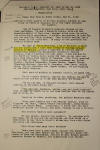
|
2.
31 May 1928.
Newspaper article, "Interview with
Soldier of General Sandino, Wounded in
Arm, Tells of Fight at Calpules where
279 Women Defeated the Yankees"
(trans.), La Nueva Prensa, San
José, 31 May 1931, p. 2.
" . . . Enclosure
No 1, dispatch No. 1225 of May 31, 1928
¶ American Legation, San Jose, Costa
Rica. ¶ TRANSLATION ¶ (News item from LA
NEUVA PRENSA, May 31, 1928) ¶ INTERVIEW
WITH SOLDIER OF GENERAL SANDINO, WOUNDED
IN ARM, TELLS OF FIGHT AT CALPULES WHERE
279 WOMEN DEFEATED THE YANKEES. ¶ One of
General Sandino’s soldiers knocked at
our door yesterday. He was a Mosquito
Indian, with all the characteristics of
that race, amongst which were his color,
his melancholic expression, a certain
nervousness in speaking and one earlobe
being pierced. This Sandino soldier has
a bad wound in the right arm. In reply
to our questions the Sandino soldier
said: ¶ My name is Celio Martinez, I am
of Mosquito origin; but for years past I
have been living in the San Domingo
section of Managua, whence I departed to
present myself voluntarily before the
Nicaraguan Liberator, General Sandino,
whom I followed for some time. I was
wounded in the fight at Ococtal, where
about 300 fell on our side and more than
twice that number of Yankees. This fight
occurred on the 12th of May. Other
wounded accompany me, Rafael Jimenez,
Benigno Hernandez, German Garcia, Samuel
Tinoco, Francisco Mairens, Jose de J.
Sequeira, Juan Leiva, Julian Leiva,
Eligio Castrillo and Simeon Vargas. We
are stopping at the Hotel Golosina. ¶
What sort of soldier is General Sandino,
we asked him. ¶ He is a great General,
replied the likeable Indian, he would
rather not eat or drink than neglect his
troops. ¶ How do you say, in Mosquito
dialect, that General Sandino is the
great Liberator? ¶ ‘Yan marainla
lukiauis, abrigo para ail Gral.
Sandino.’ That is what we heard, we do
not know whether that is the proper way
to write it. ¶ Replying to other
questions, the soldier Martinez said: ¶
Other good leaders are with General
Sandino, such as Tijerino (of Leon),
Simeon Vargas (Chinandega), and Jesus
Marenquillo and Daniel Mena.
Incidentally, I heard that the last
mentioned killed his father, don Luis,
because he was a traitor. ¶ Has General
Sandino much equipment? ¶ He has enough,
replied the soldier. He operates with
few arms, but he has all war provisions
and food stuff in a cave which he has
that is about 5 kilometers long with
hidden air-holes and entrances. ¶ Have
there been many other battles? ¶ There
have been a great many, replied the
soldier Martinez, but the most famous
was one at Calpules where 279 women of
Leon and Chinandega, dressed as men,
fought against superior forces of
Yankees, who clamorously took flight . .
. "
|
|

|
3.
31 May 1928.
Newspaper article, "Interview with
Soldier of General Sandino, Wounded in
Arm, Tells of Fight at Calpules where
279 Women Defeated the Yankees"
(trans.), La Nueva Prensa, San
José, 31 May 1931, p. 3.
" . . . The
Mosquito smiled, laughed with peculiar
malice and joy, and as we heard the tale
of Calpules, we dreamed of the suluotas
women."
|
|

|
4.
31 May 1928.
Copy of original newspaper article, "Nos
vista, herido en un brazo, un soldado
del General Sandino - Nos habla de un
combate en Calpules donde 279 mujeres,"
La Nueva Prensa, San
José, 31 May 1931, p. 4.
|
|

|
31 May 1928.
Radiogram from Major H. H. Utley to Gen.
Feland, Managua.
|
|

|
31 May 1928.
Radiogram from Major H. H. Utley to Gen.
Feland, Managua.
|
|
|
|
|
PREVIOUS
NEXT
|
|
|
|
|
|
|
|

